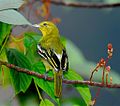| Ioras | |
|---|---|

| |
| Common iora (Aegithina tiphia) | |
| Scientific classification | |
| Domain: | Eukaryota |
| Kingdom: | Animalia |
| Phylum: | Chordata |
| Class: | Aves |
| Order: | Passeriformes |
| Superfamily: | Malaconotoidea |
| Family: | Aegithinidae G. R. Gray, 1869 |
| Genus: | Aegithina Vieillot, 1816 |
| Type species | |
| Motacilla tiphia[1] Linnaeus, 1758
| |
| Species | |
|
See text | |
The ioras are a small family, Aegithinidae, of four passerine bird species found in south and southeast Asia. The family is composed of a single genus, Aegithina. They were formerly grouped with the leafbirds and fairy-bluebirds, in the family Irenidae.
Taxonomy and systematics
[edit]The genus Aegithina was introduced in 1816 by the French ornithologist Louis Pierre Vieillot to accommodate the common iora.[2][3] The genus name is from Ancient Greek aigithos or aiginthos, a mythical bird mentioned by Aristotle and other classical authors.[4] The common iora was described in 1758 and given the binomial name Motacilla tiphia by Carl Linnaeus, but there was a some confusion about the nature of bird Linnaeus was referring to. Early taxonomists considered it to variously be a warbler, flycatcher, finch or babbler. When G. R. Gray erected the family Aegithinidae in 1869 he included a number of babbler genera in it with the ioras. Edward Blyth, working in the 1850s, was the first to connect the ioras with the leafbirds and fairy-bluebirds, and included all these with the bulbuls.[5]
Species of Aegithinidae
[edit]| Image | Common Name | Scientific name | Distribution |
|---|---|---|---|
 |
Common iora | Aegithina tiphia | Indian subcontinent and Southeast Asia |
 |
Marshall's iora | Aegithina nigrolutea | India and Sri Lanka. |
 |
Green iora | Aegithina viridissima | Thai-Malay Peninsula, Sumatra and Borneo |
 |
Great iora | Aegithina lafresnayei | Cambodia, China, Laos, Malaysia, Myanmar, Thailand, and Vietnam. |
Description
[edit]The ioras are small to medium small sized passerines, ranging from 11.5 to 15.5 cm (4.5–6.1 in) in length. Overall the males are larger than the females.[6] These are reminiscent of the bulbuls, but whereas that group tends to be drab in colouration, the ioras are more brightly coloured. The group exhibits sexual dimorphism in its plumage, with the males being brightly plumaged in yellows and greens. Unlike the leafbirds, ioras have thin legs, and their bills are proportionately longer. Calls are strident whistles; songs are musical to human ears.[7][8]
Habitat and distribution
[edit]
Their habitats include acacia scrub, forest edge, and closed forests, as well as agricultural land and (in the common iora) gardens.[7] They are generally lowland birds, with most reaching only as high as the submontane forests. They are generally highly arboreal and usually occur in the tree canopy, with only very rare records of this family coming down to the ground. The family is overwhelmingly non-migratory, although in West India there is some evidence that Marshall's ioras and common ioras are partly migratory in the seasonal semi-desert fringe.[6]
Behaviour and ecology
[edit]Ioras eat insects and spiders, which they find by nimbly gleaning the leaves of the slenderest outer twigs.[7]
In the two species whose male courtship displays are known, they are elaborate, culminating in the males' parachute-style descent looking like "green balls of fluff". The nests are compact open cups felted to branches with spiderweb. Females lay 2 or 3 eggs, which have pinkish speckles and red and purple lines. They incubate at night; the males, by day. Incubation lasts about 14 days.[7] Both parents are responsible for brooding and feeding the chicks.[6]
Relationship with humans
[edit]Ioras will commonly live close to humans and even lives in the suburbs of cites like Singapore. They are mostly not threatened by human activities, although the green iora is listed as near threatened by the IUCN, habitat loss being responsible for its decline. Unlike many other passerines they are not common species in the cage bird trade.
References
[edit]- ^ "Aegithinidae". aviansystematics.org. The Trust for Avian Systematics. Retrieved 2023-07-16.
- ^ Vieillot, Louis Pierre (1816). Analyse d'une Nouvelle Ornithologie Élémentaire (in French). Paris: Deterville/self. p. 44.
- ^ Mayr, Ernst; Greenway, James C. Jr, eds. (1960). Check-List of Birds of the World. Vol. 9. Cambridge, Massachusetts: Museum of Comparative Zoology. p. 300.
- ^ Jobling, James A. (2010). The Helm Dictionary of Scientific Bird Names. London: Christopher Helm. p. 33. ISBN 978-1-4081-2501-4.
- ^ Wells, D (2018). del Hoyo, Josep; Elliott, Andrew; Sargatal, Jordi; Christie, David A; de Juana, Eduardo (eds.). "Ioras (Aegithinidae)". Handbook of the Birds of the World Alive. Barcelona: Lynx Edicions. Retrieved 4 August 2018.
- ^ a b c Wells, David (2005), "Family Aegithinidae (Ioras)", in del Hoyo, Josep; Elliott, Andrew; Christie, David (eds.), Handbook of the Birds of the World. Volume 10, Cuckoo-shrikes to Thrushes, Barcelona: Lynx Edicions, pp. 278–290, ISBN 84-87334-72-5
- ^ a b c d Mead, Christopher J.; Wells, D. R. (2003). "Ioras". In Perrins, Christopher (ed.). The Firefly Encyclopedia of Birds. Firefly Books. p. 507. ISBN 1-55297-777-3.
- ^ Hume, AO (1877). "Remarks on the genus Iora". Stray Feathers. 5: 420–452.
External links
[edit]- Iora videos, photos & sounds on the Internet Bird Collection







